Reducing Wind Erosion through Agroforestry: A Case Study Using Large Eddy Simulations
Abstract
1. Introduction
2. Methods
2.1. Site Description
2.2. Measurements
2.3. Calculating the Wind Speed at 0.5 m Height
2.4. Potential Wind Erosion
2.5. Wind Speed Threshold Estimation
2.6. Wind Speed and Potential Wind Erosion inside the Agroforestry System
2.6.1. Large Eddy Simulation Model
2.6.2. Wind Speed Reduction
2.6.3. Potential Wind Erosion
3. Results
3.1. Overall Reduction of Wind Speed and Potential Wind Erosion inside the Alley Cropping System
3.2. Effect of Wind Direction on Wind Speed and Potential Wind Erosion
3.3. Effect of Tree Height and Distance between Tree Strips on Wind Speed and Potential Wind Erosion
3.4. Effect of Tree Strip Density on Potential Wind Erosion
3.5. Effect of Wind Speed Magnitude on Wind Speed Reduction and Potential Wind Erosion
4. Discussion
4.1. Design Parameters of a Tree Strip in an Alley Cropping System
4.2. Designing and Maintaining an Alley Cropping System
4.3. Uncertainties and Limitations of Our Modeled Wind Erosion Estimates
5. Conclusions
Author Contributions
Funding
Institutional Review Board Statement
Informed Consent Statement
Data Availability Statement
Acknowledgments
Conflicts of Interest
References
- Chepil, W.; Woodruff, N. The Physics of Wind Erosion and its Control. Adv. Agron. 1963, 15, 211–302. [Google Scholar] [CrossRef]
- Skidmore, E.L. Wind erosion control. Clim. Change 1986, 9, 209–218. [Google Scholar] [CrossRef]
- Riksen, M.J.; De Graaff, J. On-site and off-site effects of wind erosion on European light soils. Land Degrad. Dev. 2001, 12, 1–11. [Google Scholar] [CrossRef]
- Borrelli, P.; Ballabio, C.; Panagos, P.; Montanarella, L. Wind erosion susceptibility of European soils. Geoderma 2014, 232–234, 471–478. [Google Scholar] [CrossRef]
- Godfray, H.C.J.; Beddington, J.R.; Crute, I.R.; Haddad, L.; Lawrence, D.; Muir, J.F.; Pretty, J.; Robinson, S.; Thomas, S.M.; Toulmin, C. Food Security: The Challenge of Feeding 9 Billion People. Science 2010, 327, 812–818. [Google Scholar] [CrossRef]
- IPCC. Summary for policymakers. In Climate Change 2021: The Physical Science Basis. Contribution of Working Group I to the Sixth Assessment Report of the Intergovernmental Panel on Climate Change; Masson-Delmotte, V., Zhai, P., Pirani, A., Connors, S.L., Péan, C., Berger, S., Caud, N., Chen, Y., Goldfarb, L., Gomis, M.I., et al., Eds.; Cambridge University Press: Cambridge, UK; New York, NY, USA, 2021; pp. 3–32. [Google Scholar] [CrossRef]
- Garrity, D. Agroforestry and the achievement of the Millennium Development Goals. Agrofor. Syst. 2004, 61-62, 5–17. [Google Scholar] [CrossRef]
- Wilson, M.H.; Lovell, S.T. Agroforestry—The next step in sustainable and resilient agriculture. Sustainability 2016, 8, 574. [Google Scholar] [CrossRef]
- Skidmore, E.L. Wind erosion climatic erosivity. Clim. Chang. 1986, 9, 195–208. [Google Scholar] [CrossRef]
- Lee, J.J.; Phillips, D.L.; Dodson, R.F. Sensitivity of the US corn belt to climate change and elevated CO2: II. Soil erosion and organic carbon. Agric. Syst. 1996, 52, 503–521. [Google Scholar] [CrossRef]
- Skidmore, E.L.; Hagen, L.J. Reducing Wind Erosion with Barriers. Trans. ASAE 1977, 20, 0911–0915. [Google Scholar] [CrossRef]
- Brandle, J.; Hodges, L.; Zhou, X. Windbreaks in North American agricultural systems. Agrofor. Syst. 2004, 61–62, 65–78. [Google Scholar] [CrossRef]
- Böhm, C.; Kanzler, M.; Freese, D. Wind speed reductions as influenced by woody hedgerows grown for biomass in short rotation alley cropping systems in Germany. Agrofor. Syst. 2014, 88, 579–591. [Google Scholar] [CrossRef]
- Skidmore, E.L. Assessing Wind Erosion Forces: Directions and Relative Magnitudes. Soil Sci. Soc. Am. J. 1965, 29, 587. [Google Scholar] [CrossRef]
- Hagen, L.J. Windbreak Design for Optimum Wind Erosion Control. Publ. Great Plains Agric. Counc. 1976, 78, 31–36. [Google Scholar]
- Stoeckeler, J. Shelterbelt Influence on Great Plains Field Environment and Crops: A Guide for Determining Design and Orientation; Technical report; USDA: Washington, DC, USA, 1962. [Google Scholar]
- McNaughton, K. 1. Effects of windbreaks on turbulent transport and microclimate. Agric. Ecosyst. Environ. 1988, 22–23, 17–39. [Google Scholar] [CrossRef]
- Nord, M. Shelter effects of vegetation belts—Results of field measurements. Bound.-Layer Meteorol. 1991, 54, 363–385. [Google Scholar] [CrossRef]
- Cleugh, H.A. Effects of windbreaks on airflow, microclimates and crop yields. Agrofor. Syst. 1998, 41, 55–84. [Google Scholar] [CrossRef]
- Michels, K.; Lamers, J.P.A.; Buerkert, A. Effects of windbreak species and mulching on wind erosion and millet yield in the Sahel. Exp. Agric. 1998, 34, 449–464. [Google Scholar] [CrossRef]
- McAneney, K.J.; Judd, M.J. Multiple windbreaks: An aeolean ensemble. Bound.-Layer Meteorol. 1991, 54, 129–146. [Google Scholar] [CrossRef]
- Judd, M.J.; Raupach, M.R.; Finnigan, J.J. A wind tunnel study of turbulent flow around single and multiple windbreaks, part I: Velocity fields. Bound.-Layer Meteorol. 1996, 80, 127–165. [Google Scholar] [CrossRef]
- Frank, C.; Ruck, B. Double-arranged mound-mounted shelterbelts: Influence of porosity on wind reduction between the shelters. Environ. Fluid Mech. 2005, 5, 267–292. [Google Scholar] [CrossRef]
- Wolz, K.J.; Lovell, S.T.; Branham, B.E.; Eddy, W.C.; Keeley, K.; Revord, R.S.; Wander, M.M.; Yang, W.H.; DeLucia, E.H. Frontiers in alley cropping: Transformative solutions for temperate agriculture. Glob. Change Biol. 2018, 24, 883–894. [Google Scholar] [CrossRef] [PubMed]
- Garrett, H.E.; Wolz, K.J.; Walter, W.D.; Godsey, L.D.; McGraw, R.L. Alley Cropping Practices. In North American Agroforestry; Wiley: Hoboken, NJ, USA, 2021; Chapter 7; pp. 163–204. [Google Scholar] [CrossRef]
- Markwitz, C. Micrometeorological measurements and numerical simulations of turbulence and evapotranspiration over agroforestry. Ph.D Thesis, Georg-August-University Göttingen, Göttingen, Germany, 2021. [Google Scholar] [CrossRef]
- Smith, J.; Pearce, B.D.; Wolfe, M.S. A European perspective for developing modern multifunctional agroforestry systems for sustainable intensification. Renew. Agric. Food Syst. 2012, 27, 323–332. [Google Scholar] [CrossRef]
- Schoeneberger, M.; Bentrup, G.; de Gooijer, H.; Soolanayakanahally, R.; Sauer, T.; Brandle, J.; Zhou, X.; Current, D. Branching out: Agroforestry as a climate change mitigation and adaptation tool for agriculture. J. Soil Water Conserv. 2012, 67, 128A–136A. [Google Scholar] [CrossRef]
- Cardinael, R.; Cadisch, G.; Gosme, M.; Oelbermann, M.; van Noordwijk, M. Climate change mitigation and adaptation in agriculture: Why agroforestry should be part of the solution. Agric. Ecosyst. Environ. 2021, 319, 107555. [Google Scholar] [CrossRef]
- Montagnini, F.; Nair, P. Carbon sequestration: An underexploited environmental benefit of agroforestry systems. Agrofor. Syst. 2004, 61–62, 281–295. [Google Scholar] [CrossRef]
- Schoeneberger, M.M. Agroforestry: Working trees for sequestering carbon on agricultural lands. Agrofor. Syst. 2009, 75, 27–37. [Google Scholar] [CrossRef]
- Jose, S. Agroforestry for ecosystem services and environmental benefits: An overview. Agrofor. Syst. 2009, 76, 1–10. [Google Scholar] [CrossRef]
- Torralba, M.; Fagerholm, N.; Burgess, P.J.; Moreno, G.; Plieninger, T. Do European agroforestry systems enhance biodiversity and ecosystem services? A meta-analysis. Agric. Ecosyst. Environ. 2016, 230, 150–161. [Google Scholar] [CrossRef]
- Beule, L.; Karlovsky, P. Tree rows in temperate agroforestry croplands alter the composition of soil bacterial communities. PLoS ONE 2021, 16, e0246919. [Google Scholar] [CrossRef]
- Smith, J.; Pearce, B.D.; Wolfe, M.S. Reconciling productivity with protection of the environment: Is temperate agroforestry the answer? Renew. Agric. Food Syst. 2013, 28, 80–92. [Google Scholar] [CrossRef]
- Nerlich, K.; Graeff-Hönninger, S.; Claupein, W. Agroforestry in Europe: A review of the disappearance of traditional systems and development of modern agroforestry practices, with emphasis on experiences in Germany. Agrofor. Syst. 2013, 87, 475–492. [Google Scholar] [CrossRef]
- van Ramshorst, J.G.V.; Coenders-Gerrits, M.; Schilperoort, B.; van de Wiel, B.J.H.; Izett, J.G.; Selker, J.S.; Higgins, C.W.; Savenije, H.H.G.; van de Giesen, N.C. Revisiting wind speed measurements using actively heated fiber optics: A wind tunnel study. Atmos. Meas. Tech. 2020, 13, 5423–5439. [Google Scholar] [CrossRef]
- Jähn, M.; Knoth, O.; König, M.; Vogelsberg, U. ASAM v2.7: A compressible atmospheric model with a Cartesian cut cell approach. Geosci. Model Dev. 2015, 8, 317–340. [Google Scholar] [CrossRef]
- Schmidt, M.; Corre, M.D.; Kim, B.; Morley, J.; Göbel, L.; Sharma, A.S.I.; Setriuc, S.; Veldkamp, E. Nutrient saturation of crop monocultures and agroforestry indicated by nutrient response efficiency. Nutr. Cycl. Agroecosyst. 2021, 119, 69–82. [Google Scholar] [CrossRef]
- Markwitz, C.; Knohl, A.; Siebicke, L. Evapotranspiration over agroforestry sites in Germany. Biogeosciences 2020, 17, 5183–5208. [Google Scholar] [CrossRef]
- Fryrear, D.W.; Stout, J.E.; Hagen, L.J.; Vories, E.D. Wind Erosion: Field Measurement and Analysis. Trans. ASAE 1991, 34, 0155. [Google Scholar] [CrossRef]
- Funk, R.; Engel, W. Investigations with a field wind tunnel to estimate the wind erosion risk of row crops. Soil Tillage Res. 2015, 145, 224–232. [Google Scholar] [CrossRef]
- Zobeck, T.M.; Van Pelt, R.S. Wind Erosion. In Soil Management: Building a Stable Base for Agriculture; Number January; Soil Science Society of America: Madison, WI, USA, 2015; pp. 209–227. [Google Scholar] [CrossRef]
- Priestley, C. Turbulent Transfer in the Lower Atmosphere; Chicago University Press: Chicago, IL, USA, 1959; p. 130. [Google Scholar]
- Optis, M.; Monahan, A.; Bosveld, F.C. Moving Beyond Monin–Obukhov Similarity Theory in Modelling Wind-Speed Profiles in the Lower Atmospheric Boundary Layer under Stable Stratification. Bound.-Layer Meteorol. 2014, 153, 497–514. [Google Scholar] [CrossRef]
- Stull, R.B. (Ed.) An Introduction to Boundary Layer Meteorology; Springer: Dordrecht, The Netherlands, 1988. [Google Scholar] [CrossRef]
- Högström, U.; Hunt, J.C.R.; Smedman, A.S. Theory and Measurements for Turbulence Spectra and Variances in the Atmospheric Neutral Surface Layer. Bound.-Layer Meteorol. 2002, 103, 101–124. [Google Scholar] [CrossRef]
- Foken, T. 50 Years of the Monin–Obukhov Similarity Theory. Bound.-Layer Meteorol. 2006, 119, 431–447. [Google Scholar] [CrossRef]
- Marticorena, B.; Bergametti, G. Modeling the atmospheric dust cycle: 1. Design of a soil-derived dust emission scheme. J. Geophys. Res. 1995, 100, 16415. [Google Scholar] [CrossRef]
- Potter, K.N.; Williams, J.R.; Larney, F.J.; Bullock, M.S. Evaluation of EPIC’s wind erosion submodel using data from southern Alberta. Can. J. Soil Sci. 1998, 78, 485–492. [Google Scholar] [CrossRef]
- Jarrah, M.; Mayel, S.; Tatarko, J.; Funk, R.; Kuka, K. A review of wind erosion models: Data requirements, processes, and validity. CATENA 2020, 187, 104388. [Google Scholar] [CrossRef]
- Marsham, J.H.; Hobby, M.; Allen, C.J.T.; Banks, J.R.; Bart, M.; Brooks, B.J.; Cavazos-Guerra, C.; Engelstaedter, S.; Gascoyne, M.; Lima, A.R.; et al. Meteorology and dust in the central Sahara: Observations from Fennec supersite-1 during the June 2011 Intensive Observation Period. J. Geophys. Res. Atmos. 2013, 118, 4069–4089. [Google Scholar] [CrossRef]
- Stroosnijder, L. Measurement of erosion: Is it possible? CATENA 2005, 64, 162–173. [Google Scholar] [CrossRef]
- Bird, P.R.; Bicknell, D.; Bulman, P.A.; Burke, S.J.A.; Leys, J.F.; Parker, J.N.; Van Der Sommen, F.J.; Voller, P. The role of shelter in Australia for protecting soils, plants and livestock. Agrofor. Syst. 1992, 20, 59–86. [Google Scholar] [CrossRef]
- Vigiak, O.; Sterk, G.; Warren, A.; Hagen, L.J. Spatial modeling of wind speed around windbreaks. CATENA 2003, 52, 273–288. [Google Scholar] [CrossRef]
- Gillette, D.A. Threshold friction velocities for dust production for agricultural soils. J. Geophys. Res. 1988, 93, 12645. [Google Scholar] [CrossRef]
- Thom, A.S. Momentum absorption by vegetation. Q. J. R. Meteorol. Soc. 1971, 97, 414–428. [Google Scholar] [CrossRef]
- Jacobs, A.F.; Van Boxel, J.H. Changes of the displacement height and roughness length of maize during a growing season. Agric. For. Meteorol. 1988, 42, 53–62. [Google Scholar] [CrossRef]
- Carter, M.; Gregorich, E. Soil Sampling and Methods of Analysis; CRC Press: Boca Raton, FL, USA, 2007. [Google Scholar] [CrossRef]
- Gillette, D.A.; Passi, R. Modeling dust emission caused by wind erosion. J. Geophys. Res. 1988, 93, 14233. [Google Scholar] [CrossRef]
- Langdale, G.W.; Blevins, R.L.; Karlen, D.L.; Mccool, D.K.; Nearing, M.A.; Skidmore, E.L.; Thomas, A.W.; Tyler, D.D.; Williams, J.R. Cover crop effects on soil erosion by wind and water. Cover Crops for Clean Water; Soil and Water Conservation Society: Ankeny, IA, USA, 1991; pp. 15–22. [Google Scholar]
- Wolfe, S.A.; Nickling, W.G. The protective role of sparse vegetation in wind erosion. Prog. Phys. Geogr. 1993, 17, 50–68. [Google Scholar] [CrossRef]
- Goossens, D.; Gross, J.; Spaan, W. Aeolian dust dynamics in agricultural land areas in Lower Saxony, Germany. Earth Surf. Process. Landforms 2001, 26, 701–720. [Google Scholar] [CrossRef]
- Chepil, W.S. Influence of Moisture on Erodibility of Soil by Wind. Soil Sci. Soc. Am. J. 1956, 20, 288–292. [Google Scholar] [CrossRef]
- McKenna Neuman, C.; Sanderson, S. Humidity control of particle emissions in aeolian systems. J. Geophys. Res. 2008, 113, F02S14. [Google Scholar] [CrossRef]
- Jähn, M.; Muñoz-Esparza, D.; Chouza, F.; Reitebuch, O.; Knoth, O.; Haarig, M.; Ansmann, A. Investigations of boundary layer structure, cloud characteristics and vertical mixing of aerosols at Barbados with large eddy simulations. Atmos. Chem. Phys. 2016, 16, 651–674. [Google Scholar] [CrossRef]
- Kanzler, M.; Böhm, C.; Mirck, J.; Schmitt, D.; Veste, M. Microclimate effects on evaporation and winter wheat (Triticum aestivum L.) yield within a temperate agroforestry system. Agrofor. Syst. 2019, 93, 1821–1841. [Google Scholar] [CrossRef]
- Veste, M.; Malaga Linares, R.A.; Seserman, D.M.; Freese, D.; Schmitt, D.; Wachendorf, M.; Küppers, M. Simulation of annual leaf carbon fluxes and analysis of stand structure of poplars and black locusts in an alley-cropping system, Brandenburg, Germany. In Proceedings of the 4th European Agroforestry Conference Agroforestry as Sustainable Land Use, Nijmegen, The Netherlands, 28–30 May 2018; EURAF & University of Santiago de Compostela: Lugo, Spain, 2018; pp. 488–492. [Google Scholar]
- Wang, H.; Takle, E.S. On shelter efficiency of shelterbelts in oblique wind. Agric. For. Meteorol. 1996, 81, 95–117. [Google Scholar] [CrossRef]
- Bowker, G.E.; Gillette, D.A.; Bergametti, G.; Marticorena, B. Modeling Flow Patterns in a Small Vegetated Area in the Northern Chihuahuan Desert using QUIC (Quick Urban & Industrial Complex). Environ. Fluid Mech. 2006, 6, 359–384. [Google Scholar] [CrossRef]
- Bowker, G.E.; Gillette, D.A.; Bergametti, G.; Marticorena, B.; Heist, D.K. Sand Flux Simulations at a Small Scale over a Heterogeneous Mesquite Area of the Northern Chihuahuan Desert. J. Appl. Meteorol. Climatol. 2007, 46, 1410–1422. [Google Scholar] [CrossRef]
- Dupont, S.; Bergametti, G.; Simoëns, S. Modeling aeolian erosion in presence of vegetation. J. Geophys. Res. Earth Surf. 2014, 119, 168–187. [Google Scholar] [CrossRef]
- Vacek, Z.; Řeháček, D.; Cukor, J.; Vacek, S.; Khel, T.; Sharma, R.P.; Kučera, J.; Král, J.; Papaj, V. Windbreak Efficiency in Agricultural Landscape of the Central Europe: Multiple Approaches to Wind Erosion Control. Environ. Manag. 2018, 62, 942–954. [Google Scholar] [CrossRef]
- Loeffler, A.E.; Gordon, A.M.; Gillespie, T.J. Optical porosity and windspeed reduction by coniferous windbreaks in Southern Ontario. Agrofor. Syst. 1992, 17, 119–133. [Google Scholar] [CrossRef]
- Wang, H.; Takle, E.S. On three-dimensionality of shelterbelt structure and its influences on shelter effects. Bound.-Layer Meteorol. 1996, 79, 83–105. [Google Scholar] [CrossRef]
- Řeháček, D.; Khel, T.; Kučera, J.; Vopravil, J.; Petera, M. Effect of windbreaks on wind speed reduction and soil protection against wind erosion. Soil Water Res. 2017, 12, 128–135. [Google Scholar] [CrossRef]
- Rollin, E. The influence of wind speed and direction on the reduction of wind speed leeward of a medium porous hedge. Agric. Meteorol. 1983, 30, 25–34. [Google Scholar] [CrossRef]
- Zhang, H.; Brandle, J.R.; Meyer, G.E.; Hodges, L. The relationship between open windspeed and windspeed reduction in shelter. Agrofor. Syst. 1995, 32, 297–311. [Google Scholar] [CrossRef]
- Trentacoste, E.R.; Connor, D.J.; Gómez-del Campo, M. Row orientation: Applications to productivity and design of hedgerows in horticultural and olive orchards. Sci. Hortic. 2015, 187, 15–29. [Google Scholar] [CrossRef]
- Cleugh, H.A.; Miller, J.M.; Böhm, M. Direct mechanical effects of wind on crops. Agrofor. Syst. 1998, 41, 85–112. [Google Scholar] [CrossRef]
- Sterk, G. Causes, consequences and control of wind erosion in Sahelian Africa: A review. Land Degrad. Dev. 2003, 14, 95–108. [Google Scholar] [CrossRef]
- Oteng’i, S.B.; Stigter, C.J.; Ng’ang’a, J.K.; Mungai, D.N. Wind protection in a hedged agroforestry system in semiarid Kenya. Agrofor. Syst. 2000, 50, 137–156. [Google Scholar] [CrossRef]
- Mayaud, J.; Webb, N. Vegetation in Drylands: Effects on Wind Flow and Aeolian Sediment Transport. Land 2017, 6, 64. [Google Scholar] [CrossRef]
- Bagley, W.T. 33. Agroforestry and windbreaks. Agric. Ecosyst. Environ. 1988, 22–23, 583–591. [Google Scholar] [CrossRef]
- Swieter, A.; Langhof, M.; Lamerre, J. Competition, stress and benefits: Trees and crops in the transition zone of a temperate short rotation alley cropping agroforestry system. J. Agron. Crop Sci. 2022, 208, 209–224. [Google Scholar] [CrossRef]
- Borrelli, P.; Alewell, C.; Alvarez, P.; Anache, J.A.A.; Baartman, J.; Ballabio, C.; Bezak, N.; Biddoccu, M.; Cerdà, A.; Chalise, D.; et al. Soil erosion modelling: A global review and statistical analysis. Sci. Total Environ. 2021, 780, 146494. [Google Scholar] [CrossRef]
- Bergametti, G.; Rajot, J.L.; Pierre, C.; Bouet, C.; Marticorena, B. How long does precipitation inhibit wind erosion in the Sahel? Geophys. Res. Lett. 2016, 43, 6643–6649. [Google Scholar] [CrossRef]
- Lal, R. Agroforestry systems and soil surface management of a tropical alfisol: I: Soil moisture and crop yields. Agrofor. Syst. 1989, 8, 7–29. [Google Scholar] [CrossRef]
- Durar, A.A.; Steiner, J.L.; Evett, S.R.; Skidmore, E.L. Measured and Simulated Surface Soil Drying. Agron. J. 1995, 87, 235–244. [Google Scholar] [CrossRef]
- McKenna-Neuman, C.; Nickling, W.G. A theoretical and wind tunnel investigation of the effect of capillary water on the entrainment of sediment by wind. Can. J. Soil Sci. 1989, 69, 79–96. [Google Scholar] [CrossRef]
- Pi, H.; Webb, N.P.; Huggins, D.R.; Sharratt, B. Critical standing crop residue amounts for wind erosion control in the inland Pacific Northwest, USA. CATENA 2020, 195, 104742. [Google Scholar] [CrossRef]
- Tibke, G. 5. Basic principles of wind erosion control. Agric. Ecosyst. Environ. 1988, 22–23, 103–122. [Google Scholar] [CrossRef]
- Guo, Z.; Zobeck, T.M.; Stout, J.E.; Zhang, K. The effect of wind averaging time on wind erosivity estimation. Earth Surf. Process. Landforms 2012, 37, 797–802. [Google Scholar] [CrossRef]

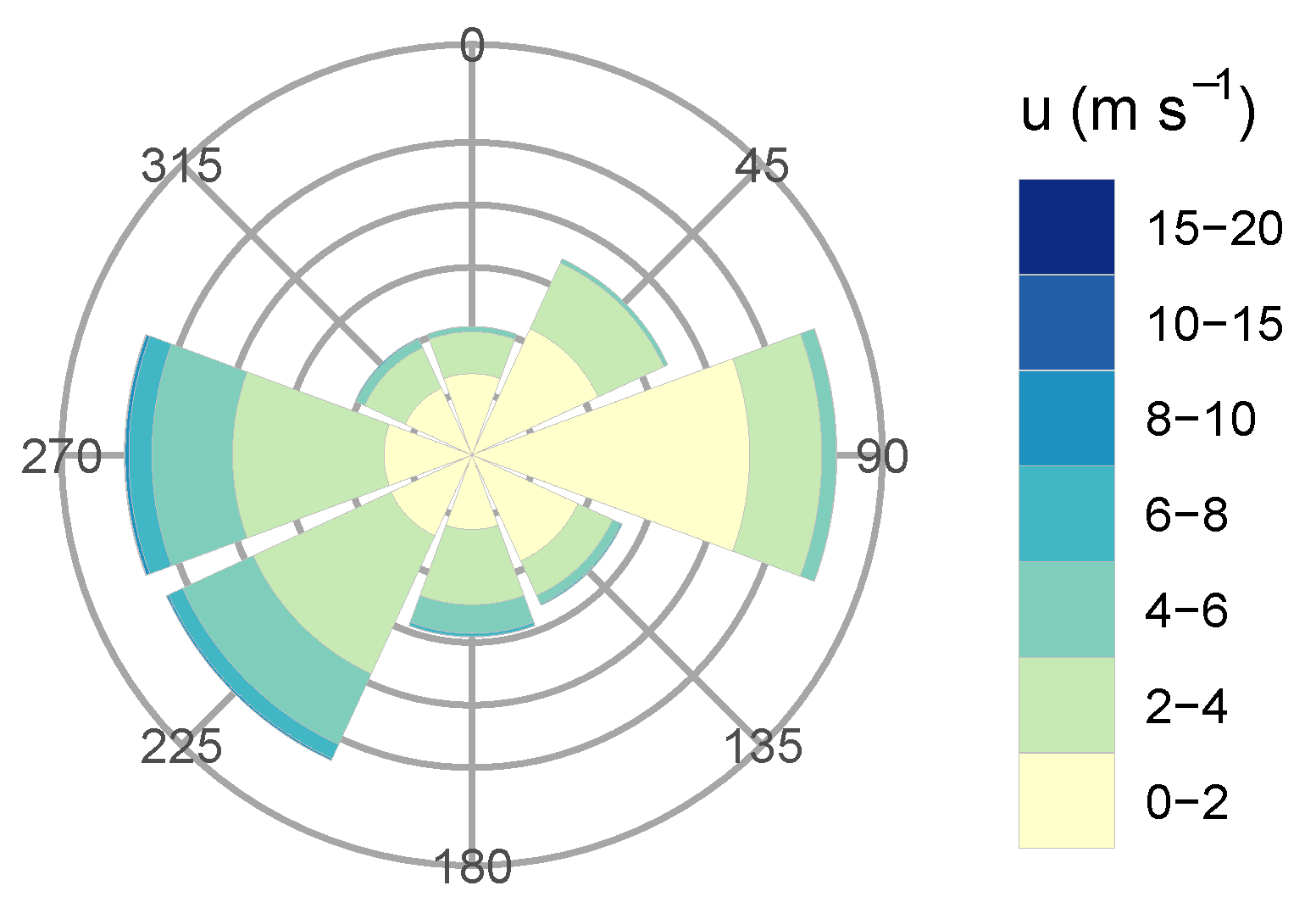
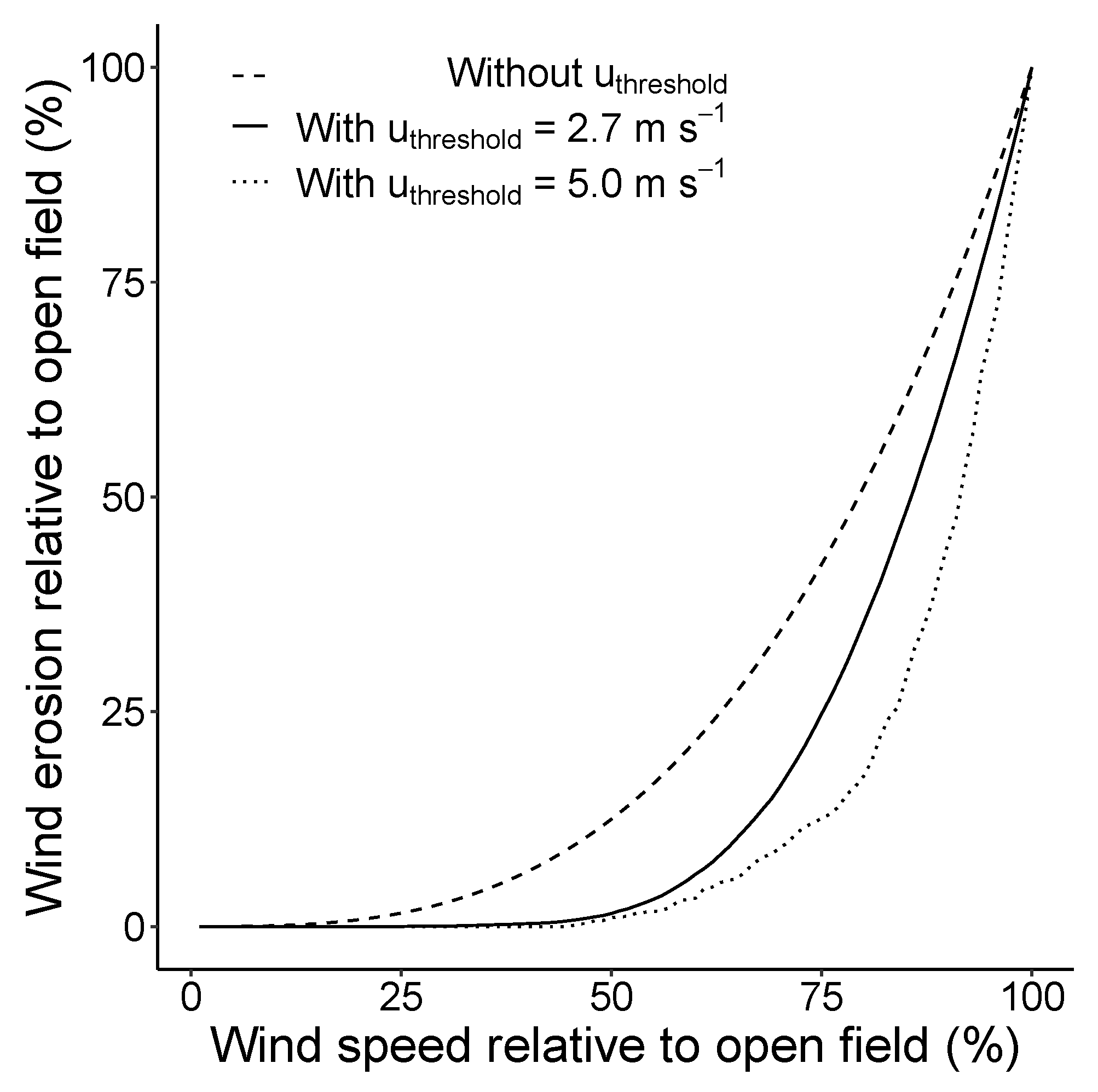
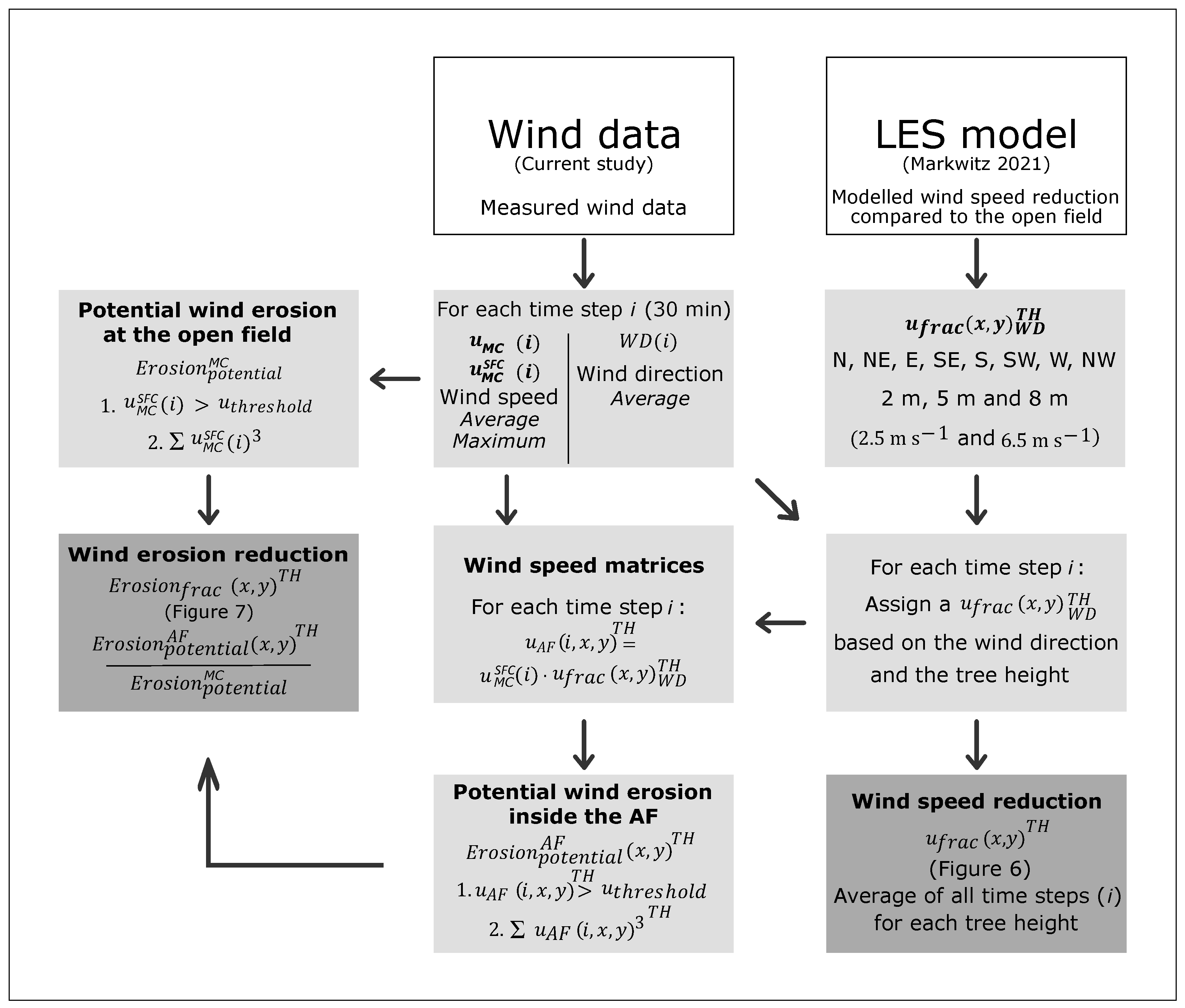

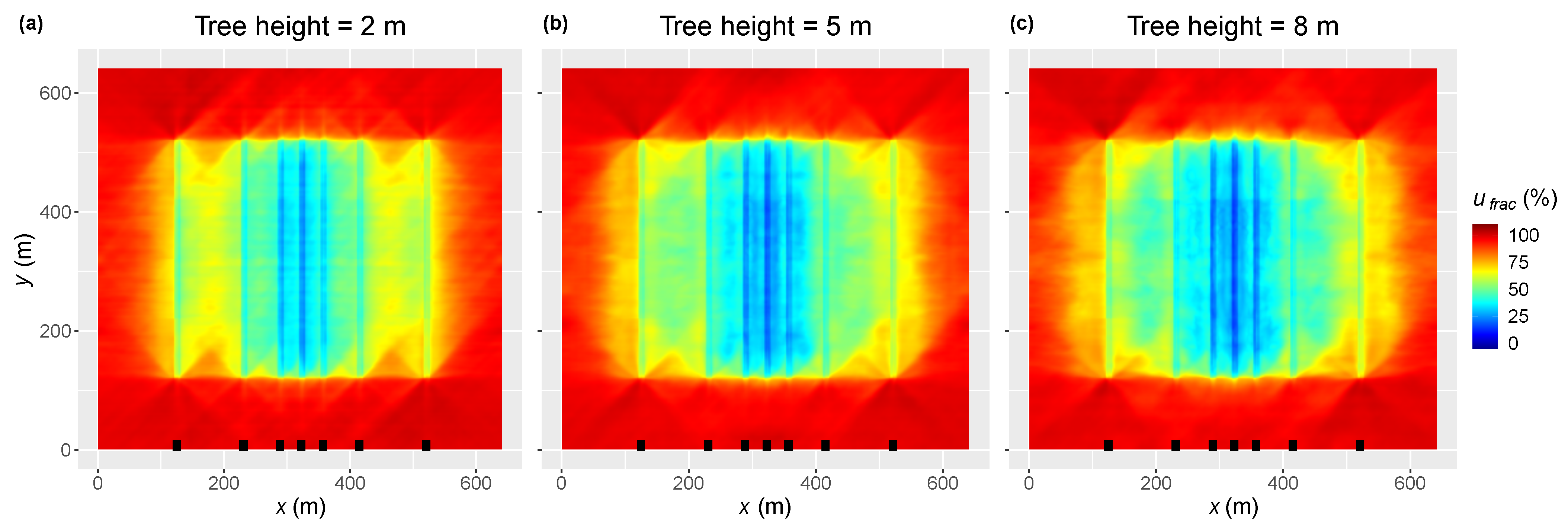
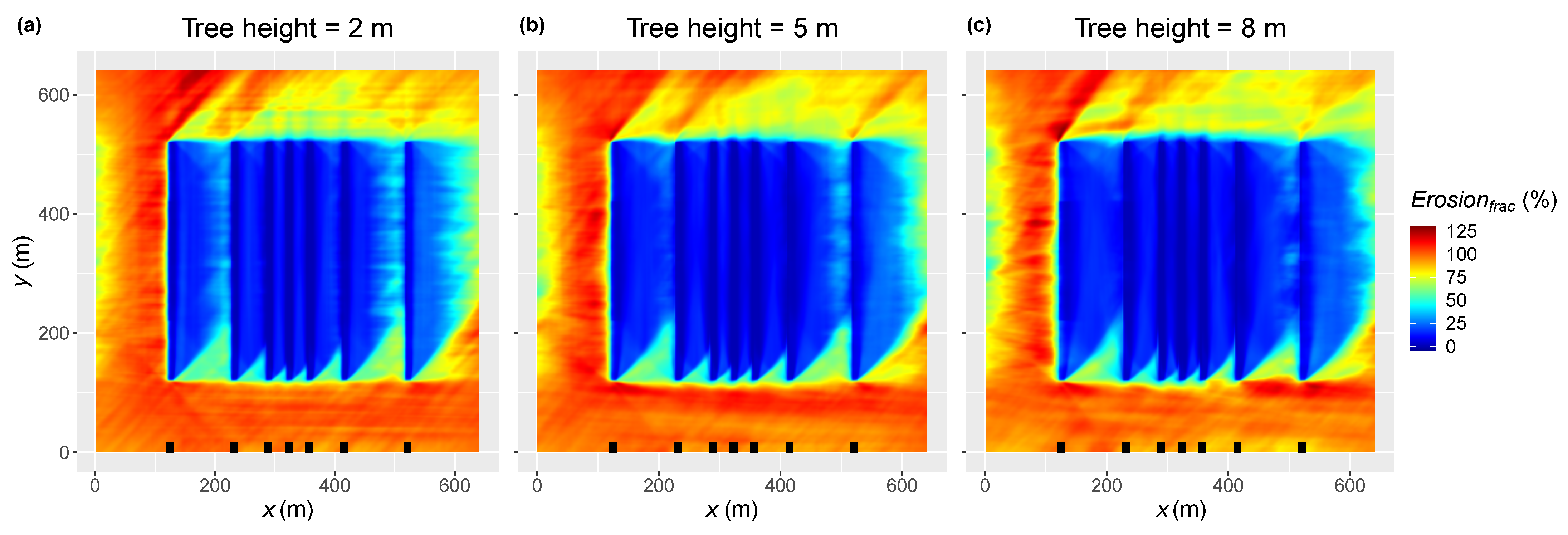
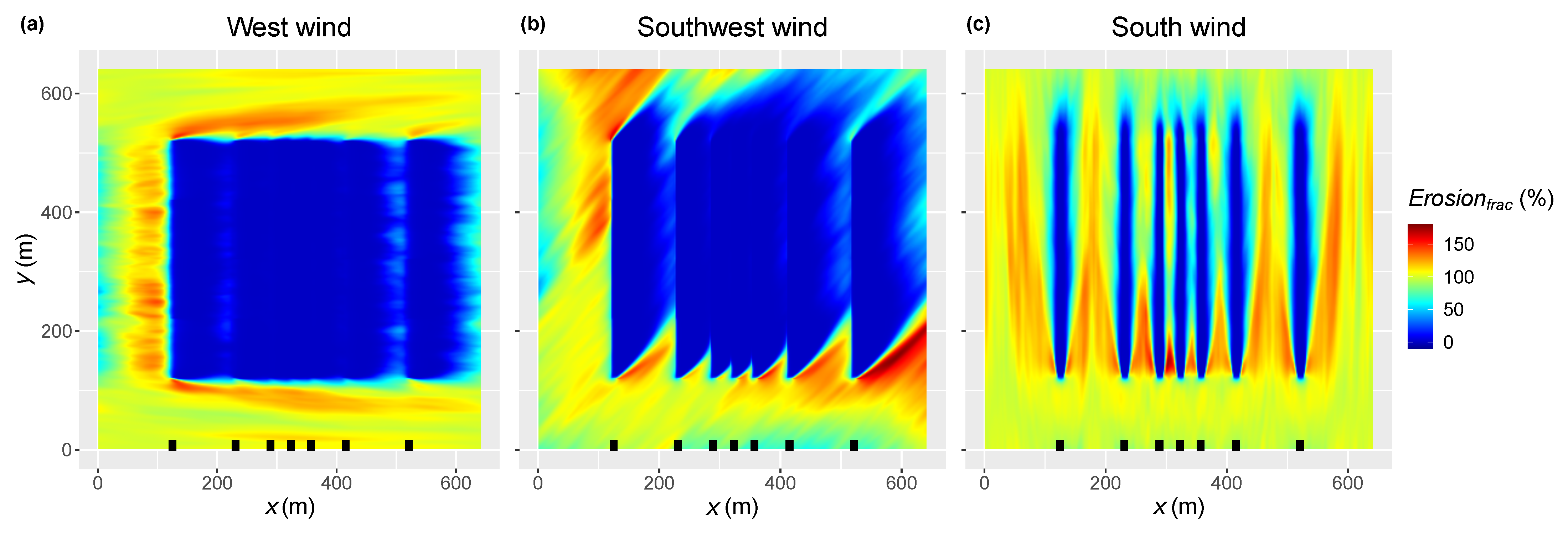
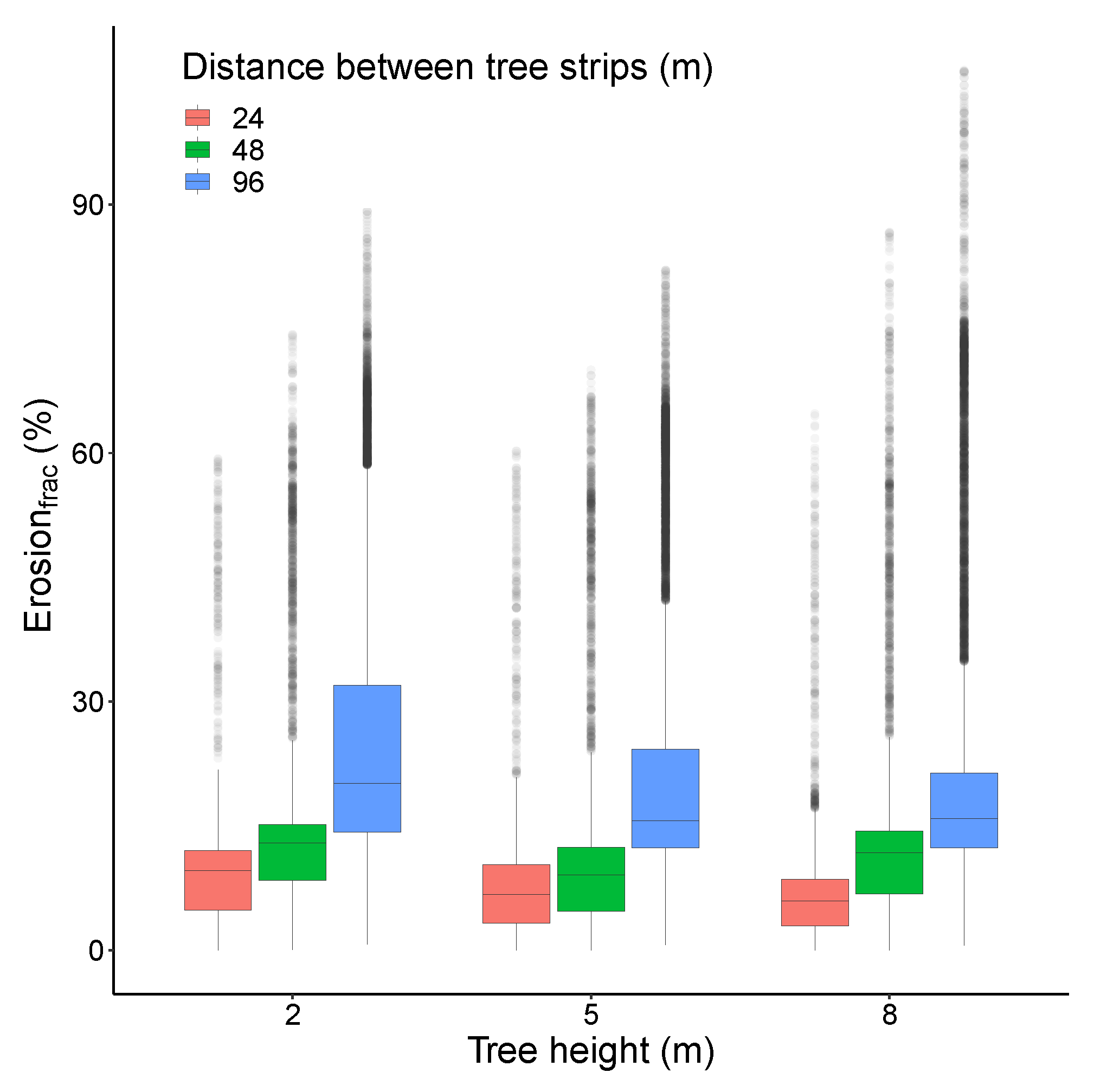

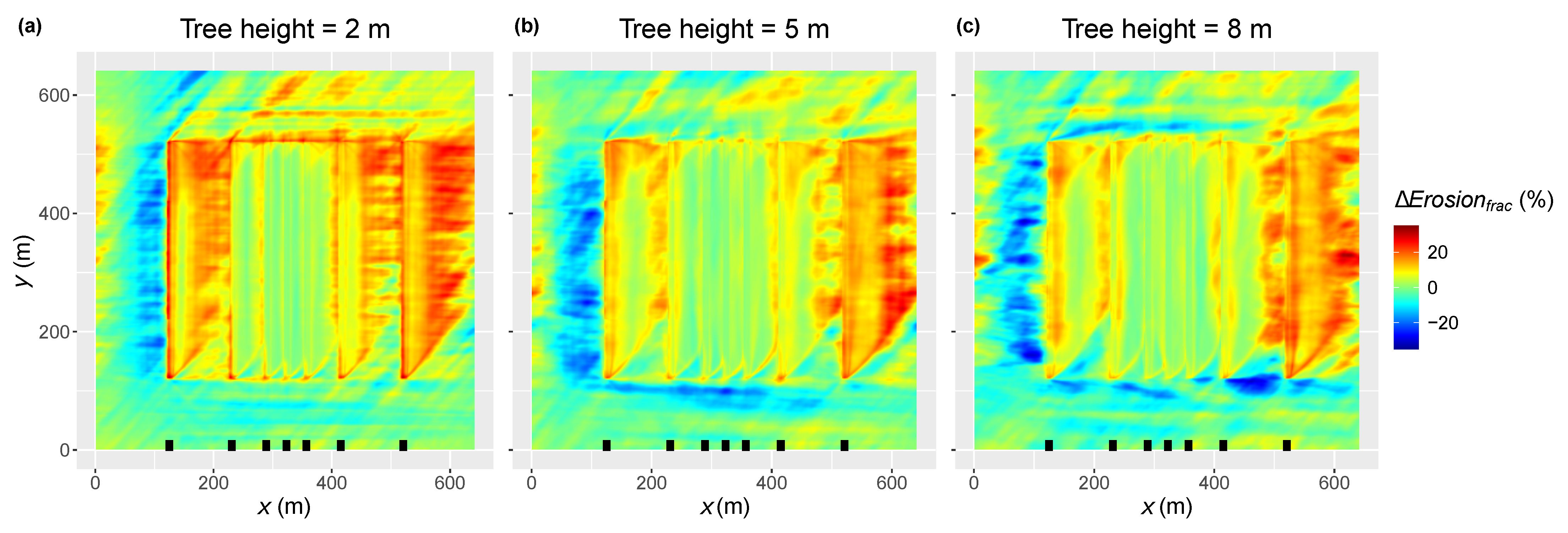
| Item | Description |
|---|---|
| Slope * | Flat |
| Landscape * | Intensively used (open) agricultural landscape |
| Trees species * | Black locust (Robinia pseudoacacia L.) and Poplar (Populus nigra L. × P. maximowiczii Henry) |
| Planting layout * | Double row |
| Width of tree strips * | 10 m |
| Long-term average temperature ** | 9.6 C |
| Average annual precipitation ** | 568 mm |
| Köppen index *** | Temperate continental climate |
| Average mean wind speed *** | 2.31 m s |
| Average maximum wind speed *** | 5.01 m s |
| Tree Height (m) | 2 | 5 | 8 |
|---|---|---|---|
| (%) | 53.7 ± 12.5 | 48.4 ± 12.7 | 47.3 ± 13.2 |
| (%) | 46.3 ± 12.5 | 51.6 ± 12.7 | 52.7 ± 13.2 |
| (%) | 17.7 ± 15.7 | 14.4 ± 14.5 | 14.8 ± 14.8 |
| (%) | 82.3 ± 15.7 | 85.6 ± 14.5 | 85.2 ± 14.8 |
| Tree Height (m) | 2 | 5 | 8 |
|---|---|---|---|
| West wind | |||
| (%) | 46.1 ± 18.3 | 38.7 ± 18.0 | 36.4 ± 18.3 |
| (%) | 53.9 ± 18.3 | 61.3 ± 18.0 | 63.6 ± 18.3 |
| Southwest wind | |||
| (%) | 48.7 ± 24.2 | 44.4 ± 25.6 | 43.5 ± 25.8 |
| (%) | 51.3 ± 24.2 | 55.6 ± 25.6 | 56.5 ± 25.8 |
| South wind | |||
| (%) | 83.1 ± 32.0 | 79.8 ± 31.0 | 81.3 ± 30.9 |
| (%) | 16.9 ± 32.0 | 20.2 ± 31.0 | 18.7 ± 30.9 |
| West wind | |||
| (%) | 7.2 ± 12.7 | 3.8 ± 8.5 | 3.3 ± 8.6 |
| (%) | 92.8 ± 12.7 | 96.2 ± 8.5 | 96.7 ± 8.6 |
| Southwest wind | |||
| (%) | 14.0 ± 30.3 | 13.0 ± 30.6 | 12.9 ± 32.5 |
| (%) | 86.0 ± 30.3 | 87.0 ± 30.6 | 87.1 ± 32.5 |
| South wind | |||
| (%) | 76.2 ± 46.7 | 65.2 ± 47.1 | 69.8 ± 51.6 |
| (%) | 23.8 ± 46.7 | 34.8 ± 47.1 | 30.2 ± 51.6 |
| Tree Height (m) | 2 | 5 | 8 |
|---|---|---|---|
| 24 m distance between tree strips | |||
| (%) | 37.4 ± 5.9 | 33.2 ± 6.7 | 33.5 ± 6.9 |
| (%) | 62.6 ± 5.9 | 66.8 ± 6.7 | 66.5 ± 6.9 |
| 48 m distance between tree strips | |||
| (%) | 48.7 ± 6.1 | 42.2 ± 7.5 | 41.8 ± 7.9 |
| (%) | 51.3 ± 6.1 | 57.8 ± 7.5 | 58.2 ± 7.9 |
| 96 m distance between tree strips | |||
| (%) | 63.5 ± 6.4 | 57.7 ± 7.0 | 56.0 ± 9.0 |
| (%) | 36.5 ± 6.4 | 42.3 ± 7.0 | 44.0 ± 9.0 |
| 24 m distance between tree strips | |||
| (%) | 9.3 ± 7.9 | 7.9 ± 7.8 | 7.1 ± 7.5 |
| (%) | 90.7 ± 7.9 | 92.1 ± 7.8 | 92.9 ± 7.5 |
| 48 m distance between tree strips | |||
| (%) | 13.6 ± 10.8 | 10.6 ± 10.6 | 12.7 ± 11.2 |
| (%) | 86.4 ± 10.8 | 89.4 ± 10.6 | 87.3 ± 11.2 |
| 96 m distance between tree strips | |||
| (%) | 25.3 ± 16.1 | 20.7 ± 15.5 | 20.4 ± 16.3 |
| (%) | 74.7 ± 16.1 | 79.3 ± 15.5 | 79.6 ± 16.3 |
| Tree Height (m) | 2 | 5 | 8 |
|---|---|---|---|
| Initial wind speed of 2.5 m s | |||
| (%) | 53.7 ± 12.5 | 48.4 ± 12.7 | 47.3 ± 13.2 |
| (%) | 46.3 ± 12.5 | 51.6 ± 12.7 | 52.7 ± 13.2 |
| Initial wind speed of 6.5 m s | |||
| (%) | 56.1 ± 13.4 | 49.0 ± 13.2 | 48.1 ± 13.0 |
| (%) | 43.9 ± 13.4 | 51.0 ± 13.2 | 51.9 ± 13.0 |
| Initial wind speed of 2.5 m s | |||
| (%) | 17.7 ± 15.7 | 14.4 ± 14.5 | 14.8 ± 14.8 |
| (%) | 82.3 ± 15.7 | 85.6 ± 14.5 | 85.2 ± 14.8 |
| Initial wind speed of 6.5 m s | |||
| (%) | 25.7 ± 13.9 | 20.0 ± 14.5 | 19.9 ± 13.9 |
| (%) | 74.3 ± 13.9 | 80.0 ± 14.5 | 80.1 ± 13.9 |
Publisher’s Note: MDPI stays neutral with regard to jurisdictional claims in published maps and institutional affiliations. |
© 2022 by the authors. Licensee MDPI, Basel, Switzerland. This article is an open access article distributed under the terms and conditions of the Creative Commons Attribution (CC BY) license (https://creativecommons.org/licenses/by/4.0/).
Share and Cite
van Ramshorst, J.G.V.; Siebicke, L.; Baumeister, M.; Moyano, F.E.; Knohl, A.; Markwitz, C. Reducing Wind Erosion through Agroforestry: A Case Study Using Large Eddy Simulations. Sustainability 2022, 14, 13372. https://doi.org/10.3390/su142013372
van Ramshorst JGV, Siebicke L, Baumeister M, Moyano FE, Knohl A, Markwitz C. Reducing Wind Erosion through Agroforestry: A Case Study Using Large Eddy Simulations. Sustainability. 2022; 14(20):13372. https://doi.org/10.3390/su142013372
Chicago/Turabian Stylevan Ramshorst, Justus G. V., Lukas Siebicke, Moritz Baumeister, Fernando E. Moyano, Alexander Knohl, and Christian Markwitz. 2022. "Reducing Wind Erosion through Agroforestry: A Case Study Using Large Eddy Simulations" Sustainability 14, no. 20: 13372. https://doi.org/10.3390/su142013372
APA Stylevan Ramshorst, J. G. V., Siebicke, L., Baumeister, M., Moyano, F. E., Knohl, A., & Markwitz, C. (2022). Reducing Wind Erosion through Agroforestry: A Case Study Using Large Eddy Simulations. Sustainability, 14(20), 13372. https://doi.org/10.3390/su142013372








